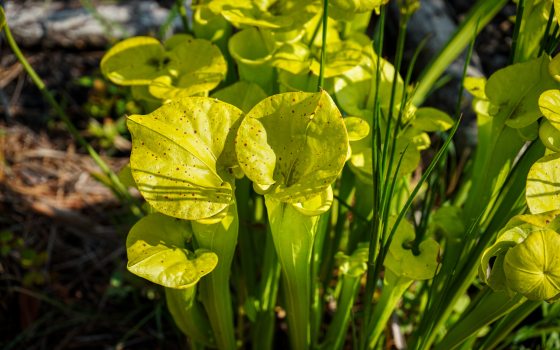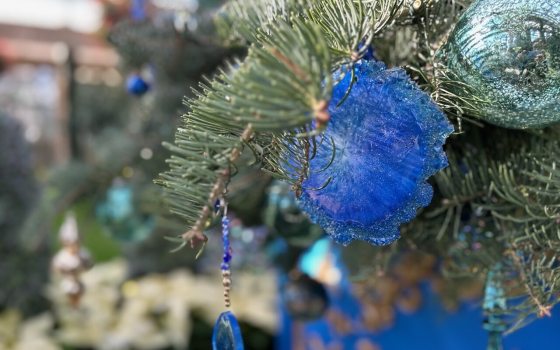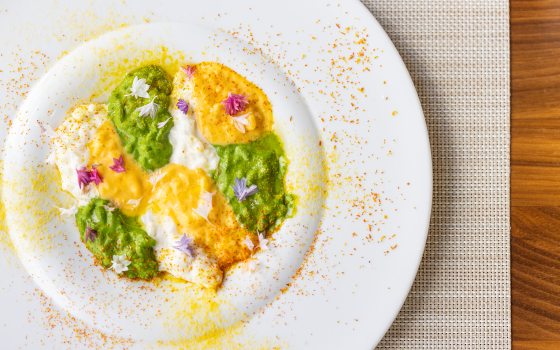In our Idea Garden, we bring horticultural inspiration closer to home, showcasing a range of gardening and design approaches, as well as plants that can be reliably grown by home gardeners in the mid-Atlantic region. With that, our Idea Garden is the perfect place for our newest addition—a bog garden. Located adjacent to our Student Exhibition Garden, our new-this-season bog garden mimics naturally occurring bogs in the eastern United States, where carnivorous plants, orchids, blueberries, and plants that like having “wet feet” can grow naturally. Here, we’ve planted more than 100 orchid plants from seven native orchid species—all of which were propagated in our lab at Longwood—as well as a variety of Sarracenia (pitcher-plant), native orchids, and more. Not only does this new bog garden serve as an interesting, beautiful representation of this type of gardening—and as a connection to Longwood’s Orchid Conservation Program—but also as an example of how you, too, can create your own bog garden.
By nature, bog gardens are miniature representations of sphagnum bog ecosystems found throughout Pennsylvania and the southeastern United States. In the wild, these habitats form in different ways, but all are characterized by being completely damp or wet, remain open due to sphagnum moss cover or other factors (such as fire), and are nutrient-poor. These habitats support an array of native plants, including many types of carnivorous plants, orchids, ericaceous plants (blueberries and their relatives), grasses, and more.
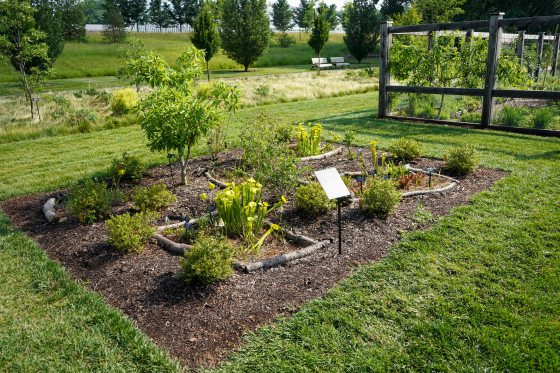
Our Idea Garden bog garden consists of five separate bog beds. Photo by Carol Gross.
In our How to Create a Bog Garden blog post from 2021, we detail how Longwood Director of Conservation Horticulture & Collections Peter Zale, Ph.D. created a personal bog garden at home, with a tour of its microhabitats and the plants best supported in the space—and how home gardeners can do the same. Much like Zale created his bog garden, we created an area of five 18-inch-deep bogs areas lined with an impermeable layer—in this case, a pond liner—and filled with a 60/40 substrate of peat and sand that supports the growth of plants that need constantly wet to damp, acidic conditions to thrive. We used a full-sun area for the bog garden, as they should be situated in full sun or in areas that get at least six hours of direct sunlight.
Our Idea Garden bog garden consists of five separate bog beds. They contain several types of Sarracenia, or North American pitcher-plants. One of the most prominent species displayed is Sarracenia flava, the yellow pitcher plant. The tall pitchers can be yellow, yellow striped with red, or even pure red. It is probably the easiest pitcher plant to grow and makes large clumps. Sarracenia x gilpinii is a naturally occurring hybrid between S. psittacina and S. rubra that form dense clusters of red pitchers with and unusual shape. These unique hybrids are grown from seed collected at the northern limit of S. psittacina in west-central Georgia, and these are proving to be hardy when forms from further south are not. That being said, nearly all species of Sarracenia are cold-hardy in southeastern Pennsylvania and grow readily in bog gardens. Nearly all species of Sarracenia are plants of conservation concern in the wild.
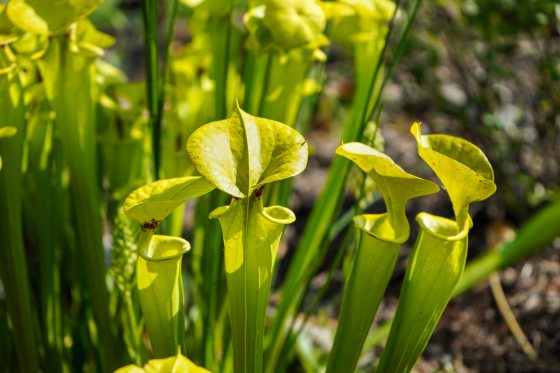
Sarracenia flava is one of the most iconic, visually stunning, and easy to grow carnivorous plants. The tube-like leaves are adapted to luring, capturing, and digesting insects as a source of nutrition. Despite the name “flava”, which means yellow, the leaves can also be red, copper-colored, or striped. Photo by Carol Gross.
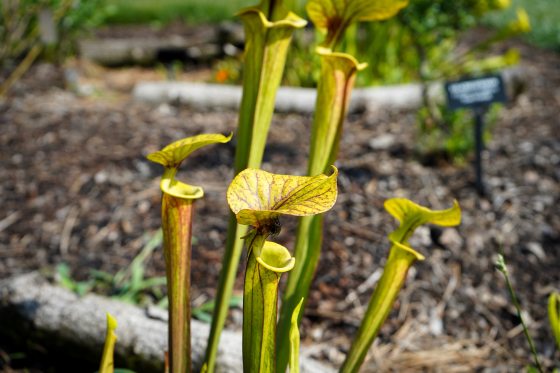
This yellow pitcher plant deceptively lures its prey using coloration and droplets of nectar produced on the leaves. Photo by Carol Gross.
When it comes to orchids in the bog garden, the most prominent native orchids are known as the fringed orchids (Platanthera). The white (P. blephariglottis), yellow or bicolor (P. x bicolor) and orange (P. ciliaris) fringed orchids can flower for several weeks through July and into August. These showy species are among the most charismatic of our native orchids, attract various species of swallowtail butterflies, and are rare species of conservation concern in Pennsylvania. Another rare Platanthera, called P. integra, was also planted in the bog garden but will not likely bloom until next year.
The grass pink (Calopogon tuberosus) is another native orchid that can be found in the bogs that was propagated in our lab. This is perhaps the easiest of all native bog orchids to grow and if conditions are right, it will even seed around. Its bright pink flowers are produced throughout June.
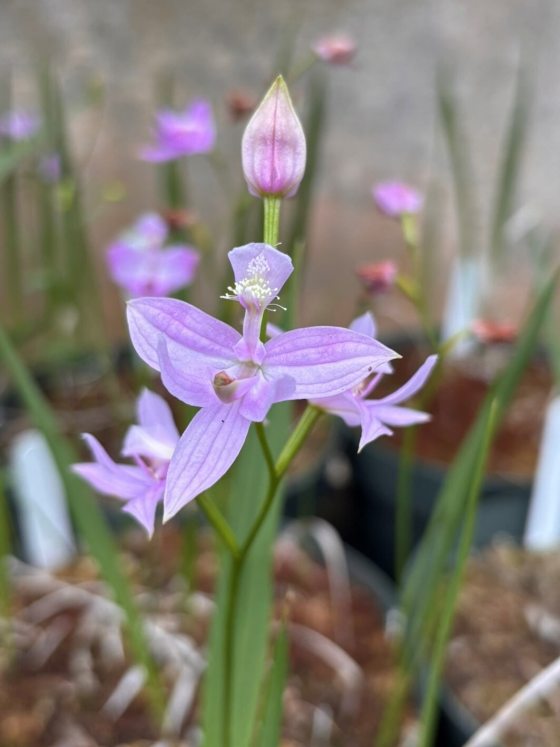
Calopogon oklahomensis is a rare species of the central US that is a beautiful component of bog gardens that is of conservation concern. Longwood Gardens is one of the first gardens to learn how to grow and propagate this species. Photo by Peter Zale, Ph.D.
Its midwestern cousin, Calopogon oklahomensis, is a species of conservation concern that can also be found in the bog garden and flowers in May. Longwood is one of the first public gardens to successfully propagate and grow this species. If you happen to be visiting Longwood this fall, you can see Atlantic lady’s tresses (Spiranthes bightensis) flowering in the bogs in October and November, with dense spikes of white fragrant flowers.
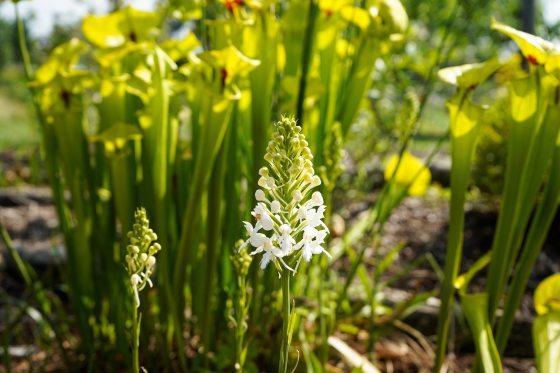
The white fringed orchid (Platanthera blephariglottis), coming into bloom in our Idea Garden bog garden. Photo by Carol Gross.
Each of the seven native orchid species in the Idea Garden bog garden were propagated here at Longwood as part of our Orchid Conservation Program. At Longwood, our work to conserve orchids takes place in the fields and forests of Pennsylvania, as well as far-reaching locations around the globe, and in our plant tissue culture laboratory.
Our research focuses on the development of innovative and sustainable techniques to grow large seedling populations of native orchids to demonstrate the critical role that horticulture plays in supporting plant conservation. Not only can seedling orchids be used to help restore orchid populations native to Pennsylvania and across the country, they can also be used to continually build a beautiful, hardy, and genetically diverse orchid collection in the outdoor gardens at Longwood.
Platanthera has been a major focus of our research. Multiple studies aimed at perfecting seed germination and cultivation practices have resulted in our ability to successfully propagate and grow these orchids, which are typically considered difficult to cultivate.
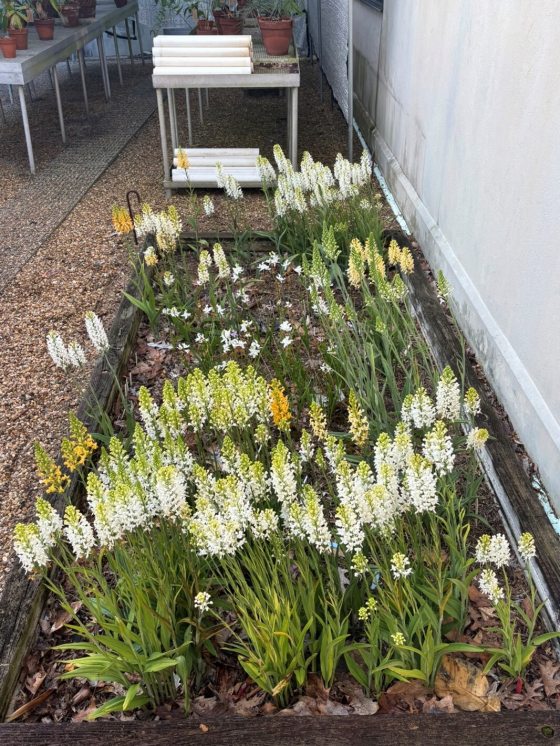
The experimental, behind-the-scenes bog garden where we grew our initial Platanthera are still getting better six years after planting. Various types of Platanthera are found in this bed in addition to the white flowering tuberous grass pink (Calopogon tuberosus). Photo by Peter Zale, Ph.D.
Seeds of almost all orchids depend on mycorrhizal fungi to induce their germination in the wild. Since bog gardens emulate soil conditions where some Platanthera species are found in the wild (acidic, low fertility, organic soils) they also create habitat for the fungi that associate with orchids. This helps create the environment the orchids need to thrive. Through use of molecular sequencing of orchid fungus DNA, we have been able to demonstrate that our behind-the-scenes bog garden is home to at least two species orchid fungi, one of which supports mature plants and one that supports seed germination. Not only have seed-grown Platanthera species been thriving in the bog for the last six years, they also have attained a size rarely seen in wild populations. Keeping an orchid’s habitat intact is at the core of conservation efforts; however, if the northeastern Pennsylvania habitat from which we collected these Platanthera seeds were to one day degrade, growing these native plants in bog gardens helps ensure they’re here to stay. With our Idea Garden bog now on display and in bloom, we can share the beauty of Platanthera with you, planted in a garden representative of their habitat.
In addition to Sarracenia and Platanthera, you can also find one of the most conspicuous plants in the summer bog garden: Senega (Polygala) lutea, known as orange milkwort or bog cheetos. This biennial species flowers through summer and politely reseeds in the bog garden. Venus fly trap (Dionaea muscipula) can also be found in the bog garden. This well-known carnivorous plant is native to bogs in North and South Carolina and is cold-hardy in our region. It has showy white flowers in addition to the characteristic leaves that trap insects. Several unusual, native blueberry species are also here. In the wild they grow in the same habitats as other species mentioned in this blog and appreciate similar conditions.
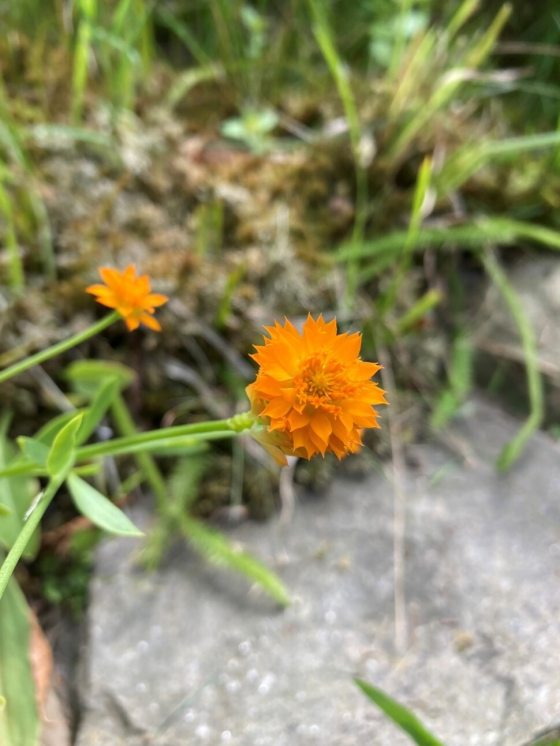
Senega (Polygala) lutea is one of the most recognizable and easy to grow bog plants. It flowers throughout the summer. Although the plants are short-lived, they often reseed and become a polite bog garden “weed”. Photo by Peter Zale, Ph.D.
Come see our Idea Garden bog for yourself—and experience the remarkable possibilities of bog gardens and the array of native plants they so beautifully support. While our bog garden’s orchids should hold their bloom for a couple more weeks, weather permitting, the garden is also intriguing without flowers—and Sarracenia will hold their pitchers all year.
